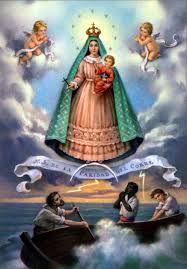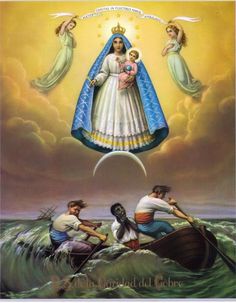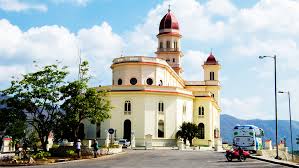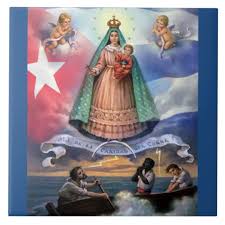 HISTORIA DE LA VIRGEN CUBANA MAMBISA: LA CARIDAD DEL COBRE.
HISTORIA DE LA VIRGEN CUBANA MAMBISA: LA CARIDAD DEL COBRE.
Para los cubanos, la Virgen de la Caridad del Cobre no es solo un mito o símbolo religioso, es parte de su identidad como nación.
Corría el mes de octubre de 1812. Los hermanos Juan y Rodrigo de Hoyos, indios nativos y moradores de Barajagua, de oficio rancheadores y monteros, invitaron a Juan Moreno, negrito de 10 años y esclavo del rey, para ir en busca de sal a las pequeñas salinas de la bahía de Nipe, dentro de la jurisdicción del hato. Descendieron en canoa por el río Barajagua hasta el Nipe y por él salieron a la bahía. Estando ya en el mar, les sorprendió una tormenta y tuvieron que refugiarse por tres días en un cayo.
Juan Moreno, ya de 85 años, en 1687 dejó su testimonio: «…y habiendo ranchado en Cayo Francés, que está en medio de dicha Bahía de Nipe, para con buen tiempo ir a la salina, estando una mañana la mar en calma salieron de dicho Cayo Francés antes de salir el sol los dichos Juan y Rodrigo de Hoyos y este declarante.
»Embarcados en una canoa para la dicha salina y apartados de dicho Cayo Francés, vieron una cosa blanca sobre la espuma del agua que no distinguieron lo que podía ser, y acercándose más les pareció pájaro y ramas secas. Dijeron dichos indios, parece una Niña, y en estos discursos, llegados reconocieron y vieron la imagen de Nuestra Señora de la Virgen Santísima con un niño Jesús en los brazos sobre una tablita pequeña y en dicha tablita unas letras grandes las cuales leyó Rodrigo de Hoyos u decían, “Yo soy la Virgen de la Caridad” y siendo sus vestiduras de ropaje se admiraron que no estaban mojadas. Y en esto llenos de gozo y alegría, cogiendo solo tres tercios de sal se vinieron para el hato de Barajagua».
Regresaron a Barajagua, a «donde estaba Miguel Galán, Mayoral de dicho hato y le dijeron lo que pasaba, de haber hallado a Nuestra Señora de la Caridad. Y el dicho Mayoral muy contento y sin dilación envió luego a Antonio Angola con la noticia de dicha Señora al Capitán Don Francisco Sánchez de Moya, quien administraba las minas del Cobre, para que dispusiese lo que habría de hacerse.
»Mientras llegaba la noticia pusieron en la casa de vivienda de dicho hato un altar de tablas, y en él a la Virgen Santísima, con luz encendida. Y puesta en su altar esta Divina Señora dicho indio Rodrigo de Hoyos cuidaba de encender la lámpara y yendo de noche a reformar dicha lámpara, no hallaba a esta Divina Señora en su altar, y dando voces dicho Rodrigo de Hoyos al Mayoral y demás personas que venían, hasta veintiuna las personas que estaban en dicho hato de Barajagua, les decía que la Virgen Santísima no estaba en su altar. Y haciendo todas las diligencias no la hallaron en su casa. Y al otro día por la mañana, volviendo a la casa, la hallaron en su altar, los vestidos mojados…».
De los milagros de la Virgen de la Caridad, el mayoral del hato de Barajagua, Miguel Galán, informó al capitán Francisco Sánchez de Moya, quien, luego, dispuso que fuera hasta el hato de Barajagua el padre Bonilla, religioso de San Francisco que estaba administrando el curato de Santiago del Prado. Lo envió acompañado de toda la infantería del Real de las minas del Cobre y mucha gente del lugar para que trajese a la Virgen Santísima.
En unas andas en procesión la llevaron a Santiago del Prado, el Cobre, y la pusieron en un altar en la iglesia parroquial del lugar, mientras le construían una ermita.
En este contexto surgió el culto a la Virgen de la Caridad del Cobre, a comienzos del siglo VII, con el mestizaje. En el ámbito político, ya menos espontáneo fue que los cobreros convirtieron el culto a la Virgen de la Caridad del Cobre en la mejor defensa para su condición de criollidad.
Por escrito no ha quedado nada en relación a desde cuando a la Virgen de la Caridad del Cobre se le comenzó a llamar la virgen mambisa. Sin embargo, se puede afirmar, por los muchos testimonios dejados, que su imagen acompañó a los insurrectos en los campos de Cuba.
Por tradición oral se dice que la imagen de la Virgen de la Caridad del Cobre que presidía el segundo altar de la Iglesia Santo Tomás, de Santiago de Cuba, en la Guerra Grande (1868-1878) fue llevada a la manigua y luego repuesta en su lugar.
Muchos fueron los mambises que a lo largo de toda la contienda por la emancipación de Cuba acudieron al Cobre para pagar promesas, dejar sus ofrendas, dar las gracias por la protección brindada por la Virgen de la Caridad. Tal vez, por estas razones fieles y heroicos mambises escribieron una carta al Papa Benedicto XV, fechada en el Santuario del Cobre el 24 de septiembre de 1915 y firmada por el general Jesús Rabí, otros seis generales, oficiales y soldados hasta un número de doscientos, solicitándole que se proclamara a la Virgen de la Caridad del Cobre Patrona de la República de Cuba. El Sumo Pontífice accedió a la petición y el 10 de mayo de 1916 firmaba el decreto de su proclamación.
«El auge del culto a la Caridad del Cobre coincidía con la recuperación de la confianza del cubano en su destino independiente, en la valía de su personalidad. Por eso no es de extrañar que Liborio —imagen del cubano sufrido—, guajiro veterano de las guerras de independencia, en oportunidades, los 8 de septiembre, fuera representado de visita en El Cobre para pagarle a Cachita una promesa».
Ambas expresiones: Liborio y Cachita, como cariñosamente le llama el pueblo a la Virgen de la Caridad, son símbolos de identidad, de cubanía: una exaltada manifestación del orgullo de ser cubano.
 HISTORY OF THE CUBAN VIRGIN MAMBISA: LA CARIDAD DEL COBRE.
HISTORY OF THE CUBAN VIRGIN MAMBISA: LA CARIDAD DEL COBRE.
For Cubans, the Virgin of La Caridad del Cobre is not only a myth or religious symbol, it is part of her identity as a nation.
It was the month of October 1812. The brothers Juan and Rodrigo de Hoyos, native Indians and residents of Barajagua, ex-officio rancheadores and monteros, invited Juan Moreno, a 10-year-old black and slave of the king, to go in search of salt. the small salt mines of Nipe Bay, within the jurisdiction of the herd. They descended in canoe by the Barajagua river until the Nipe and by him they left to the bay. Being already in the sea, they were surprised by a storm and had to take refuge for three days in a key.
Juan Moreno, already 85 years old, in 1687 left his testimony: «… and having ranched in Cayo Frances, which is in the middle of said Bay of Nipe, to have a good time to go to the salt mine, being one morning the calm sea came out of said Cayo Francés before the sun rises the said Juan and Rodrigo de Hoyos and this declarant.
»Embarked in a canoe for the said salina and separated from said French Key, they saw a white thing on the foam of the water that they did not distinguish what it could be, and approaching more it seemed to them bird and dry branches. Said these Indians, looks like a girl, and in these speeches, arrived recognized and saw the image of Our Lady of the Blessed Virgin with a child Jesus in his arms on a small board and on this small board some large letters which read Rodrigo de Hoyos u said, “I am the Virgin of Charity” and being their garments of clothing were admired that they were not wet. And in this full of joy and joy, taking only three thirds of salt came for the herd of Barajagua ».
They returned to Barajagua, to “where was Miguel Galán, Mayoral of said herd and they told him what was happening, of having found Our Lady of Charity. And the saying Mayoral very pleased and without delay sent to Antonio Angola with the news of said Lady to the Captain Don Francisco Sanchez de Moya, who administered the mines of the Copper, so that he could arrange what was to be done.
“While the news arrived, they placed an altar of tablets in the house of the herd, and in it the Blessed Virgin, with a light on. And placed on his altar this Divine Lady said Indian Rodrigo de Hoyos took care to light the lamp and going at night to reform the lamp, did not find this Divine Lady on his altar, and voices said Rodrigo de Hoyos Mayoral and others who They came, up to twenty-one people who were in said herd of Barajagua, told them that the Blessed Virgin was not on his altar. And doing all the diligences they did not find her in her house. And the next day in the morning, returning to the house, they found her on her altar, wet dresses … ».
Of the miracles of the Virgin of Charity, the overseer of the herd of Barajagua, Miguel Galán, informed Captain Francisco Sanchez de Moya, who, later, ordered that Father Bonilla, a religious from San Francisco, who was administering the curacy of Santiago del Prado. He sent him accompanied by all the infantry of the Royal Copper Mines and many people of the place to bring the Blessed Virgin.
In a litter in procession they took her to Santiago del Prado, El Cobre, and put her on an altar in the parish church of the place, while they built a hermitage.
In this context the cult to the Virgin of the Charity of the Copper arose, at the beginning of century VII, with the miscegenation. In the political arena, it was less spontaneous that the copper workers converted the cult of the Virgen de la Caridad del Cobre into the best defense for their criollo status.
In writing there has been nothing in relation to since when the Virgin of the Charity of Cobre began to be called the mambisa virgin. However, it can be affirmed, by the many testimonies left, that his image accompanied the insurgents in the fields of Cuba.
By oral tradition it is said that the image of the Virgin of the Charity of the Copper that presided over the second altar of the Santo Tomás Church, of Santiago de Cuba, in the Great War (1868-1878) was taken to the jungle and then replaced in its place.
Many were the mambises that throughout the struggle for the emancipation of Cuba came to the Copper to pay promises, to leave their offerings, to give thanks for the protection provided by the Virgin of Charity. Perhaps, for these faithful and heroic reasons Mambises wrote a letter to Pope Benedict XV, dated at the Copper Sanctuary on September 24, 1915 and signed by General Jesús Rabí, six other generals, officers and soldiers up to a number of two hundred , requesting that the Virgin of Charity of the Copper Patron of the Republic of Cuba be proclaimed. The Supreme Pontiff agreed to the request and on May 10, 1916 signed the decree of his proclamation.
«The rise of the cult to the Charity of the Copper coincided with the recovery of the confidence of the Cuban in his independent destiny, in the value of his personality. That is why it is not surprising that Liborio – an image of the Cuban suffered -, a guajiro veteran of the wars of independence, on September 8, was represented on a visit to El Cobre to pay Cachita a promise ».
Both expressions: Liborio and Cachita, as the people affectionately call the Virgin of Charity, are symbols of identity, of Cuban identity: an exalted manifestation of the pride of being Cuban.
Agencies/ Excelencias/ María J. Guerra/ Extractos/ Internet Photos/ Arnoldo Varona/ www.TheCubanHistory.com
THE CUBAN HISTORY, HOLLYWOOD.









